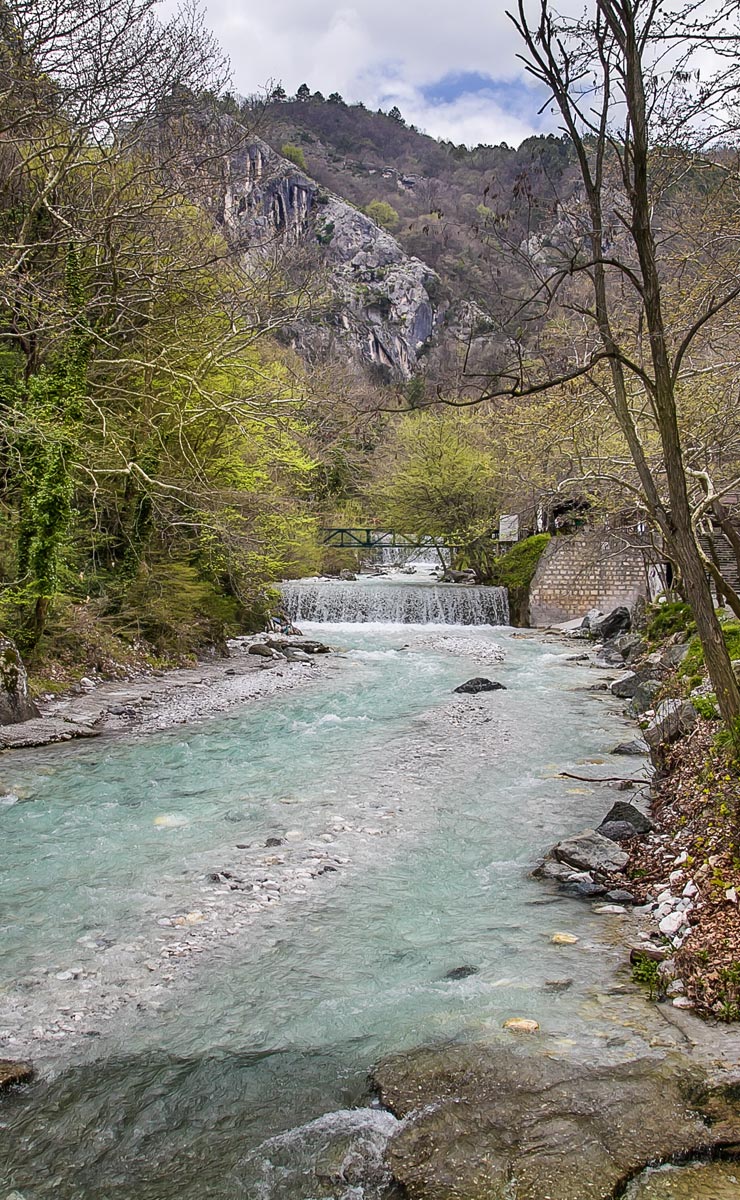Aridaia and Loutraki-Pozar - Land of Steaming Waters
Greece is a land of much geological activity. There are its infrequent earthquakes, for exmple, the last bad one of which took place in Athens in September, 1999. But, with the earth's crust full of cracks and fault lines, there is the pleasant phenomenon of rainwater which has percolated down through limestone, being infused with minerals in the process, contacting much hotter rock far below the earth's surface, and then being forced back up through fissures to the surface in the form of hot springs. The rich mineral content of the hot water has proven to be immensely beneficial to many kinds of physical ailments.
The most famous hot springs in Greece, of course, would be Thermopylae (Hot Gates), where, not far from the rising mist a tiny Spartan army held off hordes of Persian invaders at a narrow pass until they were betrayed by Efiliates, a Greek who led the Persians around the tight spot in the road via a path through the surrounding mountains.
Eighty kilometers northwest of Thessaloniki there is a delightful combination of hot springs and mountains. It is one of the most interestingly beautiful, restful, healthful places in Greece. There are not many places in the world where you can bask in the heat of a thermal pool in mid-winter and enjoy the sight of snow just a few meters away, but this is one of them.
Along a 10 km east-west corridor from Aridaia to Loutraki-Pozar are a complex of spas which, taking advantage of a network of mineral hot springs, have just about something for everyone: you can bath in a pool next to waterfalls and use the force of the falls as a sort of outdoor athlete's whirlpool for upper back pain, you can bathe in a pool that is enclosed, if the cold air bothers you, or if you want a private bath, you can find that, too.
A good soak in a hot spring not only provides immediate benefits, but those benefits can last for months. People who have used the hot springs in the Aridaia-Loutraki-Pozar ("pozar" is Russian for "fire") corridor rave about the therapeutic qualities of the water there.
In the thermal pools the mineral-filled water is a pleasant light blue in color. As the warm water enters the human body through pores opened by the heat, they help the muscular-skeletal system, particularly ailments such as joint pains, arthritis, back pain, various diseases of the muscles, tendonitis, even curvature of the spine. The nice thing about these spas is not only does one feel better immediately, but the benefits can last up to three months.
Aridaia is a small city of 9,000 on the west bank of the Almopaios River, and anchors the eastern end of this complex of spas, while Loutraki-Pozar Spa anchors the western end. Aridaia offers many spas and hotels, in addition to a Byzantine-era castle, built in the 8th century, 7 km outside the town. Aridaia was said to be built by giants which once inhabited the area. At least that's the legend; that they built the town sometime in the dim past.
It is a place that is unlike any other in Greece, with its cooler climate, snow-capped mountains in the distance, and the rising steam of its hot springs. It is a magical place of quiet, of physical healing, and of fascinating topography. The old train station in Aridaia hosts the Museum of Natural History, with exhibits featuring the unusual geology of the region, remains of the now extinct cave bear, (found in the caves near Loutraki-Pozar, which themselves can be explored), and local plant life.
A smart tourist goes where the locals go, and Aridaia-Loutraki-Pozar is an extremely popular destination for Greeks. Its close enough to Salonika for a day trip of spa-bathing, hiking, or just exploring the beautiful mountains, streams, forests and waterfalls, or, even better, ideal for a getaway week or weekend where once can bathe in the healing waters on a daily basis.
With its combination of mountain greenery, bright with colors in the autumn, and the beneficial hot springs and spas, this area is a magnet for tourists, both Greek and foreign. There are also many hiking trails in the area, particularly in the so-called Dark Forest, where the growth of large trees is so thick that little light is said to reach the ground.
It is a wonderful area to explore and enjoy, and much different than the traditional picture of Greece that most people have.











